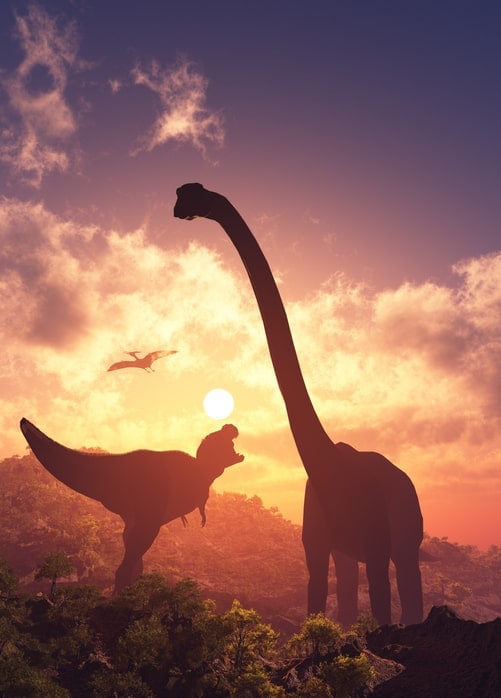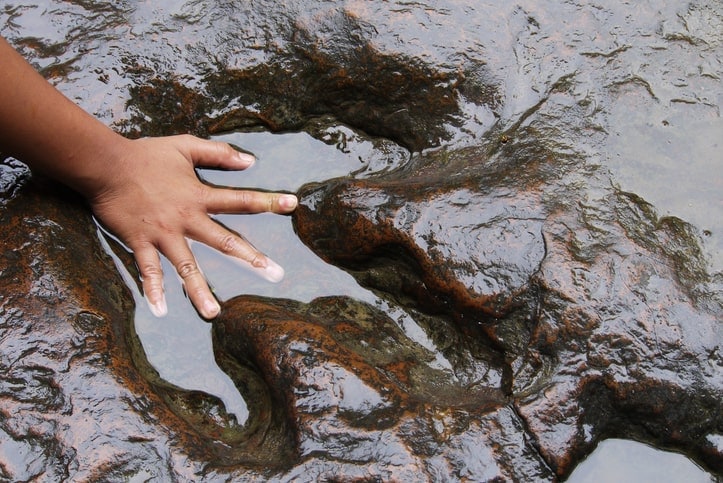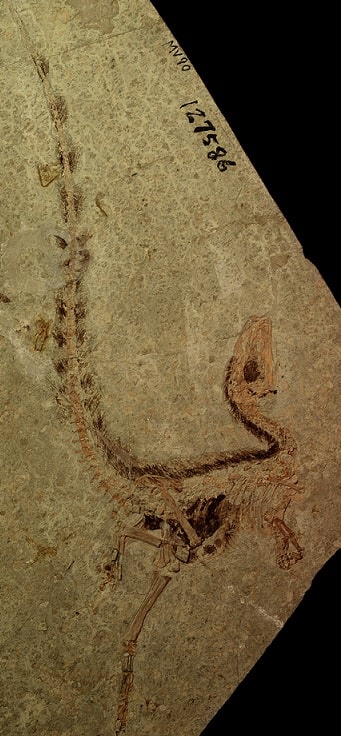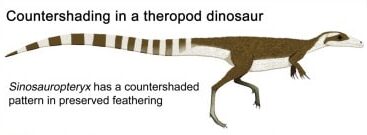Dinosaurs for kids: A gateway for STEM learning
Paleontology is a great opportunity to teach kids about biology, evolution, and scientific thinking. Most young children are fascinated by dinosaurs, and studies suggest that curiosity boosts learning. When kids are intrigued — when they have questions — their brains are especially primed to learn the answers (Fandakova and Gruber 2021).

But being keen on dinosaurs isn’t enough. It doesn’t, by itself, lead kids to a deeper understanding of biology or science. As Kathy Johnson and her colleagues found, young dinosaur experts may know a lot about specific dinosaurs, but their knowledge is usually highly specific and disconnected from larger, biological concepts (Johnson et al 2004). A perfect opportunity is being missed!
So we need to help children connect their natural interest in dinosaurs with big (and exciting) ideas. Here are my tips for making those connections. Some are based on the findings of specific studies. Others are based on my own experiences — teaching evolutionary concepts, and sampling books about dinosaurs for kids. (And are you looking to engage preschool-aged kids in dinosaur-themed activities? Check out this Parenting Science page for ideas.)
Dinosaurs for kids:Tips for turning your child’s interest into a passion for science
1. Watch out for inaccurate, outdated material, and introduce kids to the concept of fact-checking.
Paleontology is a fast-changing field, so we can’t expect a book or video program to remain state-of-the-art for long. But we should look for media that reflect what contemporary paleontologists know, and if our kids see something that’s outdated or wrong, we should tell them about it.
For instance, as paleontologist Stephen Brusatte has pointed out, the cinematic dinosaurs in Jurassic World don’t match what scientists have learned from the fossil evidence.
“Far from being a scaly-skinned reptilian monster, Velociraptor would have been a fluffy, feathered poodle from hell.” (If you’d like to see a scientifically-informed visual representation, check out this beautiful image by Dr. Witton, a paleontologist and accomplished paleoartist.)
Does this mean kids shouldn’t watch movies like Jurassic World? No! But we should seize the opportunity to (1) engage kids in conversations about the real science, and (2) introduce kids to the idea that not everything they see or read is supported by the evidence.
2. Emphasize concepts, not statistics.
It’s interesting to know how tall, long, and heavy extinct creatures were. But nobody I know ever became a scientist because he or she merely wanted to take measurements. Lessons about dinosaurs should emphasize concepts. Consistent with research on early science education, here are a few concepts that even young children can tackle:
- Animals need food to survive
- Some species are predators, others prey
- Different species may specialize in different food types (e.g., leaf eaters versus fruit eaters)
- Specific body parts can have important survival functions
- Offspring tend to resemble their birth parents
- Many species have parental care, and parental care can take different forms (including the provision of food, and protection from predators)
- Animals leave behind tracks and traces that we can study to make inferences about behavior
Young children can also go a step further, and develop a limited understanding of genetic inheritance. Parents and offspring don’t just resemble each other because they experience similar environments, or because families want to their bodies to assume a certain shape. Some traits are similar because parents have passed on certain genes, genes that (for example) make rabbits look like rabbits and not dogs. When researchers explicitly taught 5-year-olds about this, most children seemed to get it (Ergazaki et al 2015).
What next? As children develop greater familiarity with the basics, they are ready to learn about additional biology concepts, including these:
- Ecological niches (how members of a given species “make a living”; e.g., humming birds specialize in extracting nectar from long, tube-shaped flowers)
- Food chains
- Anti-predator defenses (like body size, body armor, living in groups)
- Within-species variation (individuals can possess different traits, and some of these differences can be inherited by their offspring)
- Natural selection
- Processes of fossilization
- How paleontologists infer behavior from fossils (e.g., carnivore teeth are shaped differently than herbivore teeth; large eyes imply nocturnality)
- How paleontologists reconstruct ancient environments by studying fossil plants
- How new technologies allow us to detect things (like pigments) in fossils that are invisible to the naked eye
When are kids old enough to tackle these complex ideas? Younger kids may struggle with the notion of within-species variation, an important conceptual precursor to understanding natural selection. In fact, before the age of 7, children may be especially likely to think of individuals of the same species as possessing identical traits (Bruckermann et al 2021).
But, as we’ll see, kids as young as 5 years are capable of learning about within-species variation and natural selection. The trick is finding the right approach, like the one used in an experimentally-tested picture book (see tip #4 below). And a variety of other stimulating resources are available for school-aged children.
For example, Robert Bakker’s excellent book, Raptor Pack (Step-into-Reading, Step 5), is aimed at children 7-9 years, and makes many connections to the science of animal behavior. It’s also good material for discussing critical thinking, as I note below.
Dougal Dixon’s National Geographic Kids Ultimate Dinopedia, Second Edition offers its share of statistics, but it also provides kids with brief chapters about topics like migration and herding.
In addition, cartoonist Hannah Bonner has written a delightful trio of paleontology books, now collected into a single volume called When Fish Got Feet, When Bugs Were Big, and When Dinos Dawned: A Cartoon Prehistory of Life on Earth (National Geographic Kids). Fans of Larry Gonnick will enjoy Bonner’s work.
3. Get yourself to a museum!

A good museum exhibit can deliver things no book or film can:
- the chance to see fossils and full-sized reconstructions in person;
- hands-on activities that teach kids about paleontology and the methods of paleontologists; and
- opportunities for families to work together in these activities.
Are museums effective? Research suggests that visits can be particularly valuable when families participate together, and parents ask their kids open-ended questions about what they see and infer (Jant et al 2014). So get kids talking about what they are thinking and wondering about.
4. Compare extinct animals to their living counterparts.
Natural selection is all about the ecological niche. When different species occupy similar niches, they encounter similar problems. Sometimes, they evolve similar solutions, too. By pointing out similarities between a pterosaur and a pelican, we can help kids better understand the pterosaur. We can also encourage kids to think about the broader evolutionary implications.
Are some kids too young for this approach? I doubt it. Experiments suggest that kids as young as 4 can understand analogies (Goswami and Brown 1989).
5. Introduce kids to evolutionary concepts the right way — by avoiding misconceptions that could linger for years.
As geneticist Theodosius Dobhansky famously observed, “nothing in biology makes sense except in the light of evolution.” And natural selection is the unifying theory of biology. Yet many people — even highly educated people and school teachers — misunderstand it. In fact, researchers characterize natural selection “as one of the most widely misunderstood concepts in science” (Keleman et al 2014).
Part of the problem is that our intuitions lead us astray, and misconceptions get reinforced in school. Early in life, people get taught the wrong lessons, and once those misconceptions take root, it’s very difficult to unlearn them (Keleman et al 2014).
This might lead you to think that natural selection is too complex an idea for young children to understand. But an experimental study by Deborah Keleman and her colleagues suggests otherwise. Keleman and her team created their own, 10-page picture book about a fictitious mammalian species, the “piloses.” The book presents a careful, step-by-step account of natural selection in action.
First, we see piloses use their elephant-like trunks to catch insects to eat. Then an abrupt climate change drives the insects to live underground, in narrow tunnels. Some piloses happen to have narrow trunks, so they can probe the tunnels and snatch up the insects. But other piloses — who happen to have thicker trunks — can’t do this. So they fail to survive.
Keleman presented this story to children, and then questioned the kids about their understanding. They also tested children’s abilities to generalize about what they learned — applying it to new evolutionary scenarios. The results?
Before they had heard the story, only 11% of the younger children studied (aged 5 and 6 years) showed any understanding of natural selection principles. Afterwards, 54% of them did.
Among older kids (7 and 8 years), the percentage who showed a grasp of natural selection ideas jumped from 42% to 91%.
Kids were able to infer that the thick-trunked pilosas died out, leaving only thin-trucked individuals behind. And they were able to apply their understanding to totally new scenarios (like a story that involved a species evolving larger beaks). Just as crucial, the lesson made a lasting impression. When the researchers tested these same kids 3 months later, they still showed an understanding of natural selection (Keleman et al 2014).
So it’s possible for even 5-year-olds to learn the foundations of natural selection theory — if you provide them with the right information! Keleman and her team have helped establish an approach that works.If you are interested, you can order How the Piloses Evolved Skinny Noses (Evolving Minds) from Amazon through this link. (Any purchases made using this link will earn a commission for Parenting Science.)
6. Find art that reconstructs ancient environments — not just individual creatures
Obviously, it’s helpful when artwork is visually appealing, and kids need illustrations that are scientifically accurate. But other criteria are also important. Some books about dinosaurs for kids focus on “mug shots” — each dinosaur depicted alone, against a neutral background.
That’s not just boring. It steers children away from thinking about the ecology, evolution, and behavior of these animals. It interferes with their ability to think about form and function. So seek out illustrations that provide kids with reconstructions of dinosaurs in ecological context. What did the environment look like? What creatures shared this habitat?
To see some beautiful reconstructions of extinct creatures in context, check out the websites of paleo-illustrators Mark Witton, Karen Carr, and Raúl Martín.
Zhao Chuang also does fantastic work, but doesn’t seem to have his own website. A sample of his work is featured in this interview by MyFossil.com.
7. Let kids see the evidence for themselves

Why do we know that some dinosaurs had feathers? Or think that ichthyosaurs gave birth to live young?
Some fossils give us clues about the external appearance, behavior, and environment of extinct creatures. For instance, in the photo here, you can see for yourself that this Sinosauropteryx (a Chinese dinosaur from the Cretaceous) was covered with downy feathers (rather like the modern day Kiwi bird).
Notice that the feathers running down the tail seem to occur in clumps, interrupted by apparently featherless spaces in between?
As Fiann Smithwick and his colleagues argue in a paper for Current Biology, it’s possible that this dinosaur sported a very eccentric appearance — tufts of feathers separated by patches of naked skin. But only darkly-pigmented feathers would have been preserved for us to see. If — in life — the dinosaur had any non-pigmented (white) plumage, it wouldn’t show up on this fossil. And patches of naked skin would seem unlikely. Feathers help keep an animal warm!
So Smithwick’s team interprets the visual pattern you see in this fossil as evidence that Sinosauropteryx actually had a striped or banded tail — similar to the banding we see on a raccoon. And other pigment markings on the fossil suggest that the creature had a “bandit mask” pattern on its face, as well as a dark back and light underbelly. Here’s a reconstruction from their paper:

This is just one example of the way paleontologists use fossil evidence to make inferences about how animals might have looked and behaved in life. To help give kids an idea of the variety of evidence available, I look for books that include photographs of
- fossilized impressions of skin or feathers,
- fossil footprints,
- fossil nests, and
- fossil leaves.
8. Inspire critical thinking
Paleontology presents an opportunity to teach kids about critical thinking and inductive reasoning. Too see what I mean, consider the issue of parental care.
The first discovered remains of Oviraptor were discovered over a clutch of eggs. Some people jumped to the conclusion that the animal was an egg predator. But I’m sure your child can think of an alternative explanation. What sorts of evidence can help us test this rival hypothesis?
Later finds—of adult Oviraptors sitting over nests in a chicken-like, roosting position– suggest that Oviraptor was indeed a good parent, not an egg thief (e.g., Clark et al 1999). And here is other evidence to support the idea that some dinosaurs were good parents:
- Fossil embryos. An embryo of a protosauropod species lacked well-formed teeth. It also had a very large head for its body. Together, these suggest that the baby would have moved awkwardly and had difficulty feeding on its own. It seems such babies would have benefited from parental care (Reisz et al 2005). But did they get it?
- Fossil egg shells. Eggs need to “breathe” a little, so they have pores, and some eggs are more porous than others. In a study of living birds and crocodilians, scientists found that creatures that bury their eggs have very porous eggs. By contrast, animals that keep their eggs in open-air nests have less porous eggs (a trait that helps prevent the embryo from losing too much moisture). Fossil dinosaur eggs reveal that sauropods had highly porous eggs. By contrast, some theropod dinosaurs — including Oviraptor and other members of the maniraptoran branch) had low-porosity eggs. This suggests that these dinosaurs kept their eggs in open nests — a tactic that would likely require parents to guard their eggs (Tanaka et al 2015).
- Family footprints? A trackway laid down in the mud of an ancient lake shore shows the footprints of an adult theropod dinosaur and perhaps as many as 10 juveniles of the same species. The tracks all point in the same direction, suggesting that they were walking together (Clark et al 2005).
- Clutch size. Nests of Oviraptor, Citipati, and Troodon (the dinosaur with the largest brain for its body size) have been found in association with roosting adults. These nests contained many more eggs than we’d expect one female to lay. Among living birds, species associated with such large clutches show a specific mating pattern: Males mate with multiple females, then roost the eggs themselves. We can’t assume this trend applies to dinosaurs (Birchard et al 2013), but the bird example suggests the possibility. Were the fossil adults daddy dinosaurs? Some researchers think the fossils look male (Varricchio et al 2008).
How convincing are these clues? Let kids discuss, debate, and think about them. And for younger elementary school students, try Bob Bakker’s previously mentioned Raptor Pack (Step-into-Reading, Step 5). In this engaging book, Bakker walks kids through real-life hypothesis testing that he’s conducted in the field — and makes a good case that some predatory dinosaurs shared meals with their young.
Other recommended resources
The University of California Museum of Paleontology offers an excellent collection of online exhibits, including activities about paleontology and dinosaurs for kids. For instance, the site includes these classroom activities about adaptation and extinction for 2nd and 3rd graders.
References: Paleontology and dinosaurs for kids
Birchard GF, Ruta M, and Deeming DC. 2013. Evolution of parental incubation behaviour in dinosaurs cannot be inferred from clutch mass in birds. Biol Lett. 9(4):20130036.
Bruckermann T, Fiedler D, and Harms U. 2021. Identifying precursory concepts in evolution during early childhood – a systematic literature review, Studies in Science Education. 57:1, 85-127.
Clark JM, Norell MA, and Chiappe LM. 1999. An oviraptorid skeleton from the Late Cretaceous of Ukhaa Tolgod, Mongolia, preserved in an avianlike brooding position over an oviraptorid nest. American Museum Novitates 3265. New York: American Museum of Natural History.
Clark NDL, Ross DA, and Booth P. 2005. Dinosaur Tracks from the Kilmaluag Formation (Bathonian, Middle Jurassic) of Score Bay, Isle of Skye, Scotland, UK Ichnos 12(2): 93 – 104.
Goswami U and Brown A. 1989. Melting chocolate and melting snowmen: Analogical reasoning and causal relations. Cognition 35: 69-95.
Ergazaki M, Valanidou E, Kasimati M-C, and Kalantzi M. 2015. Introducing a Precursor Model of Inheritance to Young Children International Journal of Science Education. 37(18): 3118-3142.
Fandakova Y and Gruber MJ. 2021. States of curiosity and interest enhance memory differently in adolescents and in children. Dev Sci. 24(1):e13005.
Jant EA, Haden CA, Uttal DH, Babcock E. 2014. Conversation and Object Manipulation Influence Children’s Learning in a Museum. Child Dev. 85(5):2029-45.
Johnson KE, Scott P, Mervis CB. 2004. What are theories for? Concept use throughout the continuum of dinosaur expertise. J Exp Child Psychol. 87(3):171-200.
Kelemen D, Emmons NA, Seston Schillaci R, Ganea PA. 2014. Young children can be taught basic natural selection using a picture-storybook intervention. Psychol Sci. 25(4):893-902.
O’Leary MB. 2014. How curiosity changes the brain to enhance learning. Press release for Cell Press, accessed from Eurekalert 31 October 2017: https://www.eurekalert.org/pub_releases/2014-10/cp-hcc092514.php
Reisz RR, Scott D, Sues H-D, Evans DC, and Raath, MA 2005. “Embryos of an Early Jurassic prosauropod dinosaur and their evolutionary significance”. Science 309: 761–764.
Smithwick FM, Nicholls R, Cuthill IC, Vinther J. 2017. Countershading and Stripes in the Theropod Dinosaur Sinosauropteryx Reveal Heterogeneous Habitats in the Early Cretaceous Jehol Biota. Curr Biol. 27(21):3337-3343.e2.
Tanaka K, Zelenitsky DK, Therrien F. 2015. Eggshell Porosity Provides Insight on Evolution of Nesting in Dinosaurs. PLoS One. 10(11):e0142829.
Varricchio DJ, Moore JR, Erickson GM, Norell MA, Jackson FD, and Borkowski JJ. 2008. Avian Paternal Care Had Dinosaur Origin Science 322(5909): 1826 – 1828.
Content of “Paleontology and dinosaurs for kids” last modified 4/11/2022
images credits for “Paleontology and dinosaurs for kids”:
fantasy image of dinosaurs and pterosaur silhouetted against a setting sun by istock / 1971yes
child’s hand inside fossil dinosaur footprint by istock / Userb4093267_225
images of Sinosauropteryx fossil and reconstruction © 2017 Smithwick et al, from the paper cited above. The images appear here under license [Creative Commons Attribution (CC BY 4.0)].